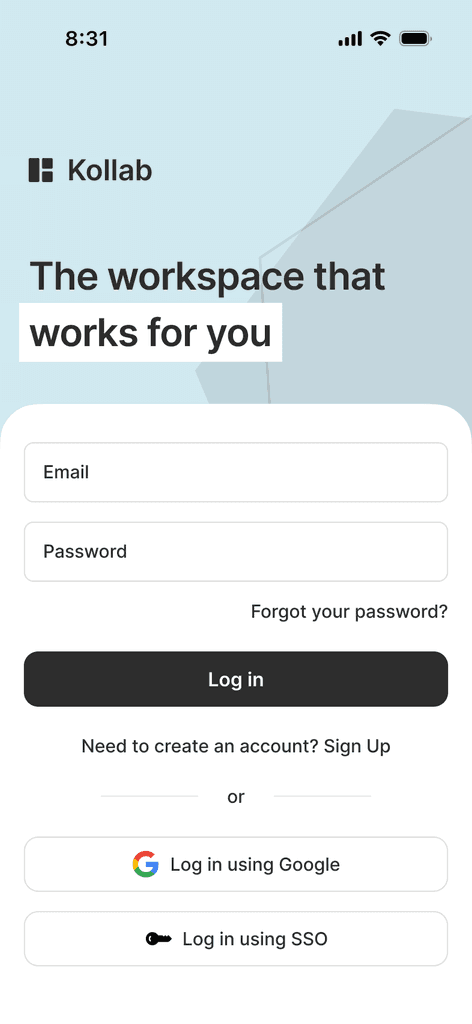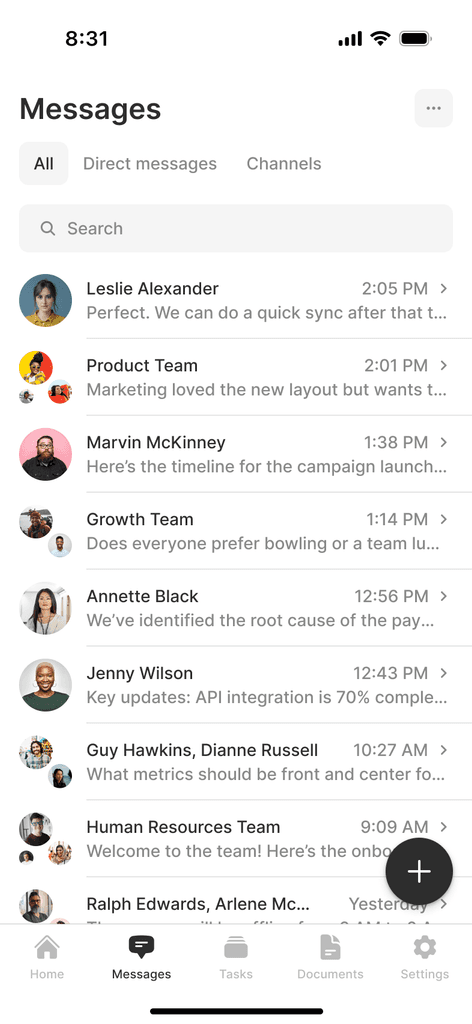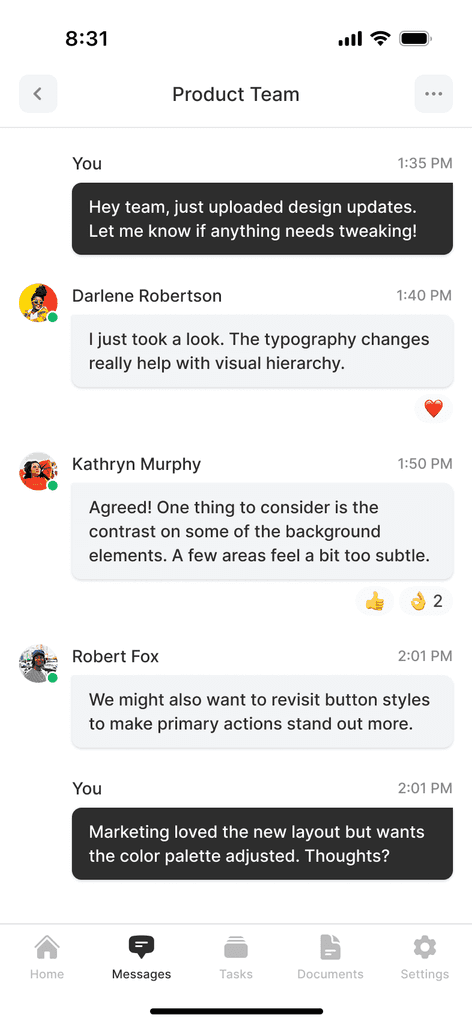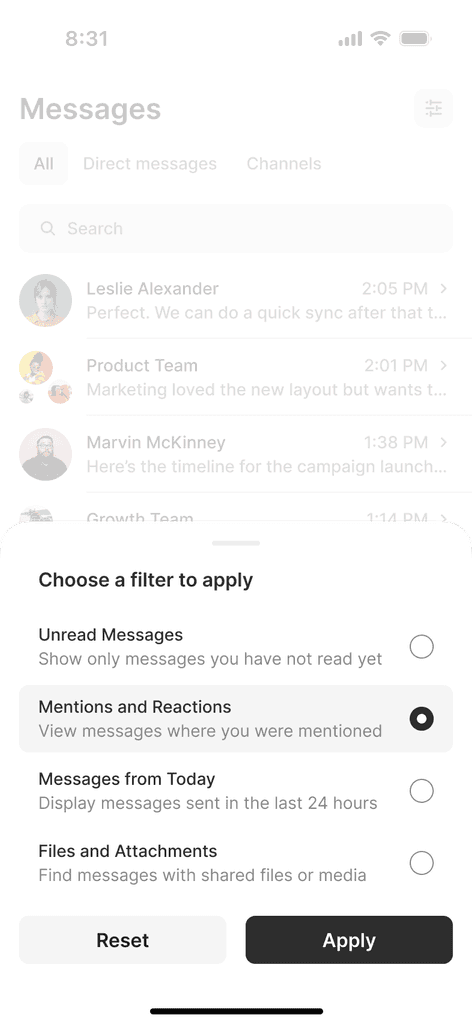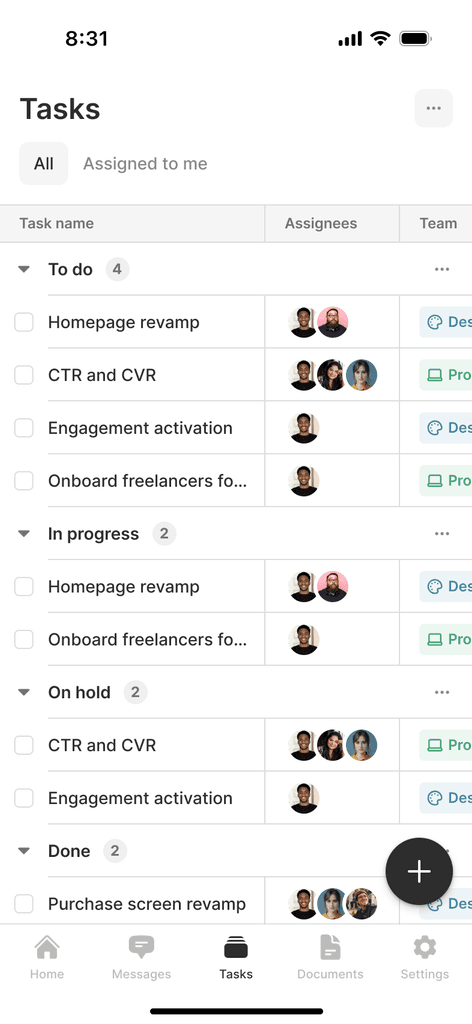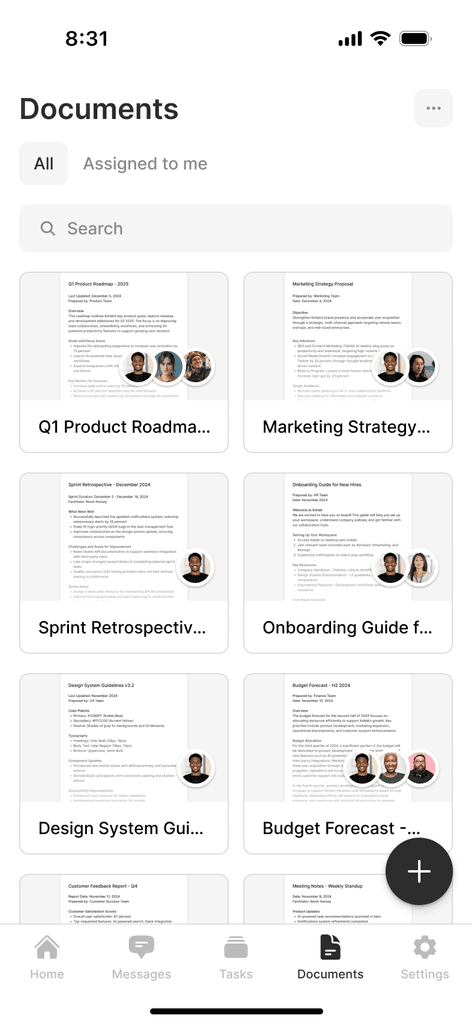Kollab
Transforming collaboration by bringing communication, task management, and file sharing together in one platform.

Project overview
Kollab is a collaboration platform designed to bring team communication, task management, and document sharing into one seamless experience.
As the sole Product Designer, I led the end-to-end design process, including user research, ideation, wireframing, prototyping, and usability testing to simulate a real-world workflow.
Timeline
2 months (Jan-Feb 2025)
Team
Product Designer
Role
Product Designer
Tools
Figma
Platform
Web application
iOS
Status
Not shipped yet
Contribution
Primary research
Concept ideation
Prototyping
High-fidelity designs
Problem context
The average employee juggles multiple apps to communicate, manage tasks, and share files, resulting in inefficiencies, miscommunication, and, ultimately, a loss of productivity.
Statistics from RingCentral report that 69% of employees waste up to an hour daily toggling between apps, equating to 32 days of lost productivity per year.
This is not just a productivity issue—it’s a financial one. A study by SHRM found that miscommunication costs companies an average of $420,000 annually, affecting their bottom line.
69%
Users who experienced productivity loss
A RingCentral study reported that 69% of employees experienced productivity loss due to the use of fragmented tools.
$11,000
Amount lost per employee annually
An HBR study shows that poor communication leads to an $11,000 loss per employee annually due to errors.
365 hours
Time spent per year on app-switching
On average, employees waste up to an hour a day toggling between multiple collaboration and communication tools.
45%
Users overwhelmed by notifications
A Forrester study revealed that reducing notification fatigue with prioritization features could improve productivity.
Core challenge
How might we create a platform that reduces app-switching, improves communication, and streamlines task management for teams?
Solution highlights
Kollab delivers an all-in-one platform designed to simplify workflows, enhance team collaboration, and boost productivity.
Research
For Kollab, I aimed to understand how collaboration tools affect productivity, grounding my design in data, user feedback, and market trends to show their impact on business efficiency.
I used qualitative and quantitative research, including surveys, interviews, and competitive analysis, to identify user pain points, valuable features, and their impact on a company's bottom line.

From the survey and interviews, I gathered four key insights about the impact of collaboration tools in the workplace.
Fragmentation leads to inefficiency
65% of participants reported productivity loss from switching between multiple apps.
Notifications impact productivity
45% of surveyed users felt overwhelmed by excessive notifications from apps.
Miscommunication creates frustration
55% of users expressed frustration with miscommunication caused by disconnected collaboration tools.
Locating information delays teams
50% of users reported spending excessive time searching for files, past messages, or task updates.
Competitive analysis
I analyzed existing collaboration apps to understand their strengths, weaknesses, and the market trends influencing user adoption.
A key trend among my analysis is the growing demand for seamless integration between communication and task management. Many teams struggle with fragmented workflows, where conversations happen in one app while tasks and projects are tracked in another.
Slack
Known for its real-time messaging, Slack is often criticized for causing "notification fatigue" due to excessive alerts.
Microsoft Teams
While popular for messaging and meetings, users often find its interface unintuitive and difficult to navigate, impacting overall efficiency.
Asana
Praised for task management, Asana lacks strong integration with real-time messaging, leading to disjointed workflows.
Business value
How Collaboration Tools Impact ROI
To align with business priorities, I focused on the value collaboration tools can provide to organizations in terms of improved productivity and cost savings. Research shows that effective collaboration platforms can lead to measurable business outcomes:
$1.27 million
Net present value
A Forrester study on Teams Rooms reported a 342% ROI over three years, with a net present value (NPV) of $1.27 million. (Forrester)
20%
Increase in profitabilty
A Salesforce report found that companies using collaboration tools saw a 20% boost in profitability due to better team alignment, faster decision-making, and higher customer satisfaction. Improved collaboration also reduced time spent on repetitive tasks, increasing productivity. (Salesforce)
25%
Reduction in operational costs
HBR reported that businesses using effective collaboration tools reduced operational costs by 25%, thanks to streamlined communication and fewer missed deadlines—crucial for scaling in remote or hybrid environments. (Harvard Business Review)
Ideation
I used a MoSCoW framework to identify "must-haves" for the MVP, such as a dashboard and integrated task management. Advanced features were categorized as "could-haves" for future iterations.




Information architecture
I designed a clear, intuitive structure that ensures that users could quickly navigate to the tools they needed.

Wireframes
I created low-fidelity wireframes to explore layouts, focusing on simplifying the user journey. For example, the Home dashboard provides a bird’s-eye view of tasks, recent files, and key updates.
Final solution
The final designs are clean, modern, and easy to read, with color-coding for tasks, conversations, and documents.

Home

Messages

Tasks, List view

Tasks, Board view

Tasks, Calendar view

Tasks, Timeline view

Documents
Testing
I conducted usability testing with participants to identify pain points in the design and evaluated feedback from similar collaboration tools.
Observing how teams communicate, manage tasks, and retrieve information helped validate design decisions and uncover additional gaps.
Positives
Enhanced search filters made archived messages easier to find.
Prioritized tasks and updates improved focus on high-priority items.
Streamlined layout boosted efficiency and reduced cognitive load.
Suggested improvements
Users requested keyword tagging and pinned results for faster search.
Collapsible sections could improve focus by hiding secondary features.
Interactive tutorials would help first-time users onboard smoothly.
More customization for widgets and notifications was a key request.
Results and impact
Although Kollab is not in development yet, I estimated the following potential impacts based on research and industry benchmarks:
Reduce app-switching time by up to 5 hours per employee weekly.
Increase task completion rates by 20% through improved tracking.
Save companies an estimated $60,000 annually for a 50-person team.
